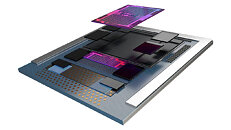AOKZOE Introduces A1 Pro Handheld Gaming Console, Powered by AMD Ryzen 7 7840U APU
AOKZOE is trying to drum up interest for its latest handheld gaming console - the A1 Pro - with a countdown to a type of early bird sale starting tomorrow. Early adopters will be offered a special starter price of just $799 for the baseline version, and that cost of entry will climb to $999 later on at retail. AOKZOE boasts that the A1 Pro is the first handheld gaming device to pack an AMD 7 7840U APU - a customized version of this SoC (AMD Z1 processor series) is set to debut as part of the ASUS ROG Ally handheld system. The current AOKZOE A1 model is powered by an older AMD Ryzen 7 6800U APU, which sat at the heart of various laptops and mobile gaming devices in 2022. This year's A1 Pro models are powerful enough to take on Valve's Steam Deck (and the previously mentioned ROG Ally) thanks to impressive internal specifications - AOKZOE reckons that the Pro upgrade offer a 20% performance leap over previous gen devices (6800U).
The Zen 4-based Ryzen 7 7840U APU, part of the "Phoenix" range of mobile processors, is available in all configurations of the A1 Pro - the base model gets 32 GB of memory and 512 GB of storage, and the headliner has 64 GB of memory and 2 TB of storage. AOKZOE states that the A1 Pro utilizes the LPDDR5-6400 RAM and PCIe 3.0 x4 standards - their handheld system is also capable of running M.2 2280 PCIe 4.0 drives. The A1 Pro features an 8-inch FHD (1920 x 1200) IPS display - its nearest rivals have smaller 7-inch screens. Hardcore game controller enthusiasts will be happy to discover that hall effect sensor technology has been integrated into the new handheld's pair of analog sticks.
The Zen 4-based Ryzen 7 7840U APU, part of the "Phoenix" range of mobile processors, is available in all configurations of the A1 Pro - the base model gets 32 GB of memory and 512 GB of storage, and the headliner has 64 GB of memory and 2 TB of storage. AOKZOE states that the A1 Pro utilizes the LPDDR5-6400 RAM and PCIe 3.0 x4 standards - their handheld system is also capable of running M.2 2280 PCIe 4.0 drives. The A1 Pro features an 8-inch FHD (1920 x 1200) IPS display - its nearest rivals have smaller 7-inch screens. Hardcore game controller enthusiasts will be happy to discover that hall effect sensor technology has been integrated into the new handheld's pair of analog sticks.


































































